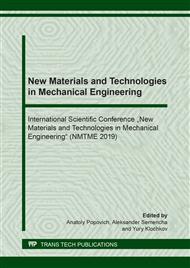[1]
A guide to the solidification of steels, Jernkontoret, Stockholm, (1977).
Google Scholar
[2]
M. El-Bealy, B. Thomas, Prediction of dendrite arm spacing for low alloy steel casting processes, Metall. Mater. Trans., 27B (1996) 689-693.
DOI: 10.1007/bf02915668
Google Scholar
[3]
O. Volkova, H.P. Heller, D. Janke, Microstructure and cleanliness of rapidly solidified steels, ISIJ Int., 43 (2003) 1724-1732.
DOI: 10.2355/isijinternational.43.1724
Google Scholar
[4]
D. Stefanescu, Microstructure evolution during solidification of steel, ISIJ Int., 46 (2006) 786-794.
DOI: 10.2355/isijinternational.46.786
Google Scholar
[5]
R. Pierer, C. Bernhard, On the influence of carbon on secondary dendrite arm spacing in steel, J. Mater. Sci., 43 (2008) 6938-6943.
DOI: 10.1007/s10853-008-2985-3
Google Scholar
[6]
V. Karlinski de Barcellos et al, Modelling of heat transfer, dendrite microstructure and grain size in continuous casting of steels, Steel Res. Int., 81 (2010) 461-471.
DOI: 10.1002/srin.201000026
Google Scholar
[7]
V.М. Golod, K. I. Emelyanov, I.G. Orlova, Dendritic microheterogeneity of cast steel: a review of problems and their computer analysis (Part I), Ferrous Metals, 8 (2013) 9-16.
Google Scholar
[8]
V.M. Golod, K.I. Emelyanov, I.G. Orlova, Dendritic microheterogeneity of cast steel: a review of problems and their computer analysis (Part 2), Ferrous Metals, 9 (2013) 25-32.
Google Scholar
[9]
A.A. Kazakov, D.V. Kiselev, A.A. Kur, E.B. Lazutova, Development of quantitative methods of assessment of structure of hypoeutectic silumins for forecasting of their mechanical properties, Tsvetnye Metally, (2014).
Google Scholar
[10]
V.M. Golod, K.D. Savelyev, A.S. Basin, Modeling and computer analysis of the crystallization of multicomponent iron-based alloys, Saint-Petersburg, Russia: Publishing house, Polytechnic University, (2008).
Google Scholar
[11]
Y.P. Adler, E.V. Markova, Yu.V. Granovskiy, experiment planning when searching for optimal conditions, Moscow, Publishing house «The Science», (1976).
Google Scholar
[12]
I.G. Orlova, V.M. Golod, K.D. Savelyev, Peculiarities of crystallization of peritectic type Fe-C-Xi multicomponent alloys, Proceed.: Foundry production today and tomorrow, Saint-Petersburg, Russia, Publishing house, Polytechnic University, (2014) 280–287.
Google Scholar
[13]
A.G. Morachevskii, E.G. Firsova, Analytical representation of the concentration dependences of the thermodynamic functions of liquid binary metallic systems with negative deviations from ideal behavior, Russian Metallurgy (Metally), (2016) 111-1155.
DOI: 10.1134/s0036029517020082
Google Scholar
[14]
A.A. Kazakov, A.S. Oryshchenko, O.V. Fomina, A.I. Zhitenev, T.V. Vikhareva, Controlling behavior of δ-ferrite in nitrogen-containing chromium–nickel–manganese steels, Inorganic Materials: Applied Research, 8 (2017) 817-826.
DOI: 10.1134/s2075113317060077
Google Scholar
[15]
M.R. Konevsky, S.V. Ryaboshuk, A.A. Kur, Effect of temperature on products of calcium phosphate interaction with carbon in the presence of silica: Thermodynamic simulation, Russian Journal Applied Chemistry, 87 (2014) 696-699.
DOI: 10.1134/s107042721406056
Google Scholar
[16]
V.M. Golod, K.D. Saveliev, Computational thermodynamics in materials science, Saint-Petersburg, Russia, Publishing house, Polytechnic University, (2010).
Google Scholar
[17]
J. Miettinen, S. Louhenkilpi , H. Kytönen, J. Laine, Thermodynamic–kinetic–empirical tool for modelling of solidification, microstructure and material properties, Math. Comp. Simu. Helsinki, Finland, 80 (2009) 1536-1550.
DOI: 10.1016/j.matcom.2009.11.002
Google Scholar
[18]
V.M. Golod, L.Yu. Dobosh, Computational materials science of structural - phase transformations in casting aluminum alloys, Int. Conf. Structural and Phase Transformations in Materials: Theory, Computer Modelling and Experiment,, 23–27 March 2017, Ekaterinburg, Russia. IOP Conference Series: Materials Science and Engineering, 192 (2017), 012027.
DOI: 10.1088/1757-899x/192/1/012027
Google Scholar
[19]
D.F. Sokolov, A.A. Vasil'ev, N.G. Kolbasnikov, S.F. Sokolov, Influence of dynamic austenite decomposition on the microstructure and mechanical properties of pipe steel, Steel, 41 (2011), 351-355.
DOI: 10.3103/s096709121104022x
Google Scholar
[20]
P.I. Rajamäki, V.A. Karkhin, P.N. Homich, Analysis of macrosegregation near fusion boundary in fusion welding, Sci. Technol. Weld. Join., (2010) 31-39.
DOI: 10.1179/136217109x449229
Google Scholar


